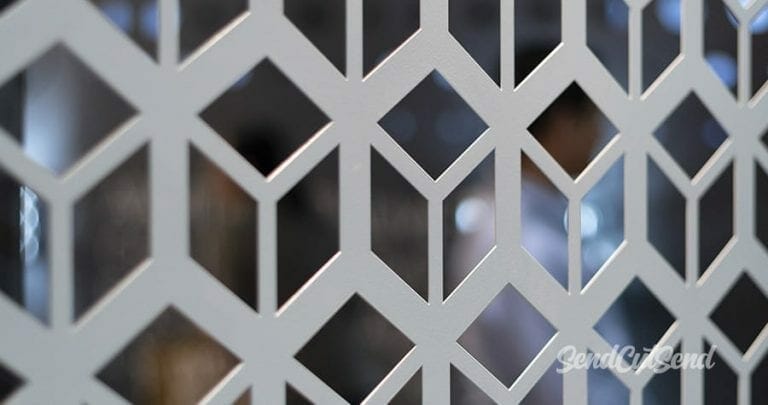New equipment options provide multiple metal cutting options. So does outsourcing. Read on.
The COVID-19 pandemic continues to reshape the metal fabricating industry. Internally, companies must do more with fewer employees due to layoffs and furloughs. Externally, companies expect more from their suppliers—faster turnaround, better pricing and turnkey services.
For small and medium sized businesses, as well as individual entrepreneurs, newer inexpensive equipment options (under $7,500) enable portable plasma, waterjet and laser cutting. Perhaps you’re considering the purchase of one or more of these systems versus sourcing your parts from a full-service metal fabricating partner. If that’s you, here are some insourcing and outsourcing pros and cons to consider.
DIY Trio for Insourcing
When it comes to metal fabricating, three cutting processes dominate:
- Plasma – Using a plasma stream formed by forcing a gas such as nitrogen, oxygen, argon or air through a narrow nozzle, this method transfers energy to a conductive work material. An electric current produced by an external power supply adds energy to the gas flow to ionize it, turning it into a plasma arc with temperatures to 40,000˚ F. The plasma arc cuts the workpiece by melting it and blows away the molten metal. Plasma cutting can be effective for cutting inches-thick metals. DIY option: Lincoln Electric’s Torchmate 4400 4×4 CNC plasma cutting table comes fully assembled and only requires compressed air, power, dedicated ground rod and water.
- Waterjet – Using pressurized water frequently mixed with abrasives such as garnet, this method cuts a range of materials, including rubber, plastics, leather, composites, ceramics and metals. DIY Option: Wazer Waterjet, a desktop system by Wazer, Inc. At 34 x 25 x 21 in., the compact offering connects to standard water and electric, has a self-contained nozzle for minimal spray and noise, requires no external ventilation and cuts steel, aluminum, glass, stone and carbon fiber.
- Laser – Using a precise focused beam of high-energy light to vaporize material,
laser cutting enables a fine level of cutting detail on myriad materials. CO2 lasers are commonly used to cut organic materials such as textiles, wood and cardboard while high-power fiber lasers are commonly used for metals. For other materials such as plastics and rubber, either can be used. DIY option: Glowforge 3D (desktop) Laser Printer by Glowforge, Inc. Technically a CNC laser-cutting engraver, this option cuts materials such as wood, leather and acrylic. As for metals, it etches some, including anodized aluminum. Others, such as stainless steel, should be treated fi laser-marking materials, such as Cermark.

Quartet of Reasons for Outsourcing
DIY equipment options provide viable options for companies desiring control over parts development. Plus, there’s the “cool’ factor associated with owning the latest systems that enable prototypes, one-offs and low-volume parts production wherever and whenever.
However, there are compelling reasons to consider outsourcing. Here are four:
- Partnerships matter. The popular pandemic rallying cry of “We’re in this together” is true of manufacturing and the supply chain. Just as metal formers now rely on press builders for turnkey systems, many parts manufacturers and OEMs are benefiting from partnerships with contract metal cutting companies. Such partnerships provide help with design files, material selection, nesting, etc.
- Strategic flexibility matters. Leaving the parts production to a trusted partner allows small and medium-sized manufacturers to focus on innovations and strategic growth plans. Plus, if there’s a problem with the cut part, a reputable partner will recut the part at no additional cost.
- Hidden costs matter. While DIY equipment is affordable, costs associated with raw materials, material storage, recycling, etc., plus the time involved with these activities must be factored in when deciding between insourcing and outsourcing.
- Time/experience matter. Portability and affordability are great, but smaller DIY machines take a long time to process parts. Also, inspired entrepreneurs lacking metal-cutting experience will spend much time figuring out how to achieve maximum equipment effectiveness—time that could be better spent designing and marketing products.
“In many cases we can ship finished parts faster than what they can be produced on these newer offerings.”
James Belosic, chief executive officer at SendCutSend, a laser-cutting company specializing in custom, small-batch fabrication.
SendCutSend’s team of fabricators, designers and software engineers can answer laser-cutting questions and help ensure a seamless process using fiber-optic laser equipment that cut up to 2200 in./min. resulting in parts in as little as three days. Parts produced include custom tooling, electronic parts and jewelry, to name a few.





